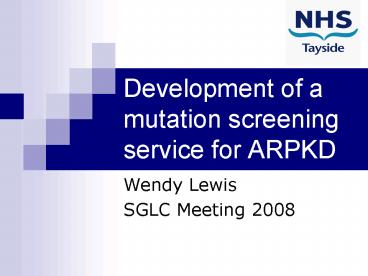Development of a mutation screening service for ARPKD - PowerPoint PPT Presentation
1 / 17
Title:
Development of a mutation screening service for ARPKD
Description:
Polycystic kidney disease can be inherited in a ... PKHD1 and the cilia. ... shown to be localized to primary cilia and concentrated to the basal body area ... – PowerPoint PPT presentation
Number of Views:41
Avg rating:3.0/5.0
Title: Development of a mutation screening service for ARPKD
1
Development of a mutation screening service for
ARPKD
- Wendy Lewis
- SGLC Meeting 2008
2
Polycystic kidney disease
- Polycystic kidney disease can be inherited in a
dominant (ADPKD) or recessive (ARPKD) manner. - ADPKD is the most commonly inherited kidney
disease (incidence of between 1800 and 11,000
live births). - ADPKD is a late onset chronic, progressive
disease. It is incurable and is characterised by
numerous fluid-filled cysts in the kidneys and
often the liver and pancreas. - Mutations have been identified in the PKD-1 and
PKD-2 genes.
3
Autosomal recessive polycystic kidney disease
(ARPKD).
- Autosomal recessive polycystic kidney disease is
an important cause of renal and liver related
morbidity and mortality in neonates and infants. - The incidence of ARPKD is estimated to be 1 in 20
000 of live births, with a estimated carrier
frequency of 1 in 71. - Severely affected neonates display
- massively enlarged echogenic kidneys
- and Potter phenotype from oligohydramnios
- due to poor foetal renal output.
4
PM of infant with ARPKD
- This infant died soon after premature birth at 23
weeks gestation from pulmonary hypoplasia as a
result of oligohydramnios. The oligohydramnios
resulted from markedly diminished foetal urine
output as a consequence of polycystic kidney
disease. Note the bilaterally enlarged kidneys
that nearly fill the abdomen below the liver. The
histological appearance in this case, coupled
with the gross appearance, was consistent with
autosomal recessive polycystic kidney disease
(ARPKD).
5
ARPKD
- About 30-50 of affected neonates die shortly
after birth from respiratory insufficiency. - Infants who survive the neonatal period or
present later in life express variable disease
phenotypes with systemic hypertension, end stage
renal disease and abnormalities following portal
hypertension. - Patients diagnosed with congenital hepatic
fibrosis and Carolis disease with minimal or no
kidney involvement are thought to be caused by
mutations at the same locus.
6
ARPKD
- Despite the variable clinical spectrum of ARPKD,
linkage studies indicate mutations at a single
locus PKHD1, is responsible for all cases of
ARPKD. - PKHD1 is amongst the largest disease genes
identified in the human genome and spans
approximately 470kb of genomic DNA. - An estimated minimum of 86 exons (12,222bp) are
assembled into a variety of alternatively spliced
transcripts ranging from 9-16 kb of the
fibrocystin/polyductin protein (FPC) .
7
Fibrocystin/polyductin (FPC)
- The longest PKHD1 transcript includes 67 exons
with an ORF composed of 66 exons and encodes the
4074 amino acid protein FPC. - Northern blot analysis of human tissue revealed a
broad, smeared signal consistant with the
existence of multiple different-sized
transcripts. - If a significant number of the alternatively
spliced products are translated, their exon
arrangements predict that both membrane-bound and
soluble proteins should be produced.
8
FPC protein structure
- FPC is a
- single transmembrane spanning receptor-like
protein - with an extensive, highly glycosylated N-terminal
extracellular region - a short cytoplasmic tail containing potential
phosphorylation sites - And is highly expressed kidney, with lower levels
in liver and pancreas.
9
PKHD1 and the cilia.
- FPC has been shown to be localized to primary
cilia and concentrated to the basal body area
common with many other cystoproteins. - The pathogenesis of the cystic phenotype in ARPKD
is not fully understood, as the function of FPC
in normal tissue is not yet known. - However the genetic and molecular data suggest
that the genesis of cysts in all polycystic
diseases is linked to the dysfunction of primary
cilia.
10
The primary cilia
11
Testing for PKHD1
- Traditionally testing for ARPKD was carried out
by linkage analysis. - Identification of the gene has enabled other
methods of mutation detection, e.g. dHPLC
analysis and sequencing. - As the gene is so large an algorithm had been
suggested where screening a subset of 27
fragments, would yield an 80 detection rate for
known severe PKHD1 mutations.
12
Aims
- This project was set up in the hope that genomic
analysis of the PKHD1 gene would provide a more
comprehensive and reliable result for our
families than linkage analysis. - We hoped to achieve a similar detection rate to
the published research groups and also develop a
full direct screening method that was relatively
simple and cost-effective.
13
- Primers were designed, ordered and optimised to
cover the suggested 27 fragments. - These were then split into three smaller groups
of between 8-13 fragments each . - A cohort of 16 families referred with a clinical
diagnosis of ARPKD or CHF and previously tested
by linkage were screened. - Our pick-up rate for two pathogenic mutations
from the 27 fragments was 33.
14
Results
- The screen was extended to cover the whole of
- the gene. A further 46 fragments were designed,
checked and optimised. - 15 mutations were identified in all. Out of
these, 4 were novel. - One family was homozygous, five families were
compound heterozygotes and in three families only
one mutation was identified. - Our final pick-up rate for families with two
identified pathogenic mutations was 40
15
ARPKD mutations detected
16
Conclusions
- Studies from phenotypically diverse referrals,
comparable to our cohort, have a pick-up rate of
47-61. - We feel that this is beneficial to our patients
to offer this as a diagnostic test. - We aim to submit a gene dossier to UKGTN to
notify our intention to set up mutation screening
for ARPKD as a service in the Dundee laboratory.
17
Further work
- Testing for large deletions is being investigated
by real time analysis using the Rotor-gene 6000.































